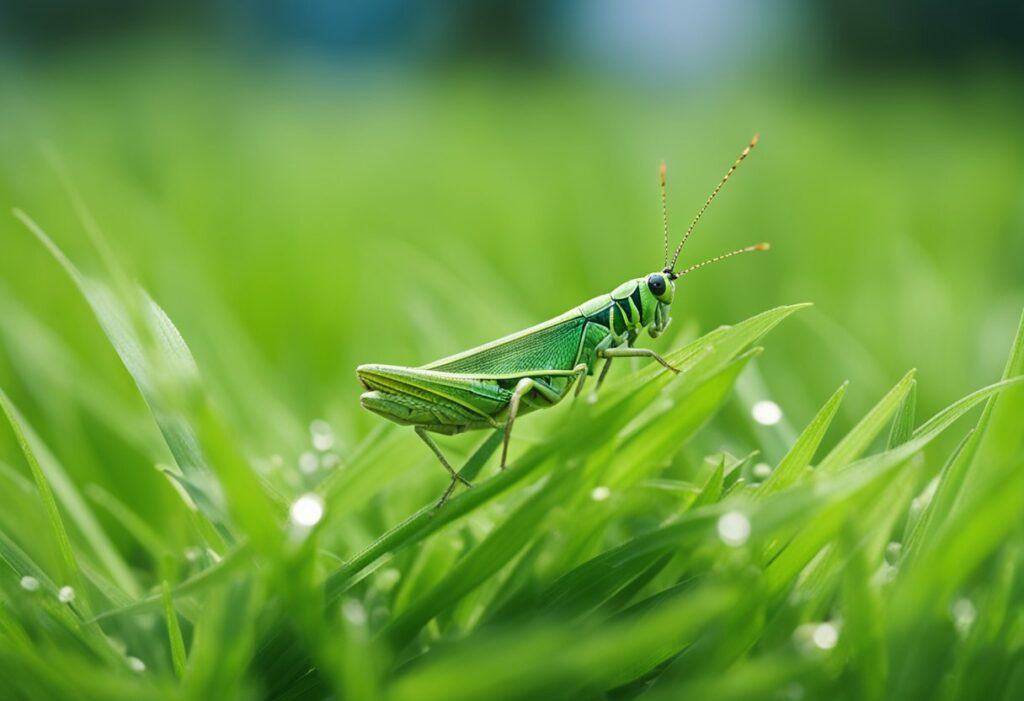Green grasshoppers are fascinating insects known for their vibrant color and unique characteristics. But did you know that they also hold spiritual significance in various cultures and belief systems?
In this article, we will explore the spiritual meaning of green grasshoppers and what encountering one may symbolize for you.
Let’s find out!
Key Takeaways
- Green grasshoppers hold spiritual significance in various cultures and belief systems.
- They are associated with growth, luck, and faith.
- Encountering a green grasshopper may hold a deeper spiritual message for you.
Table of Contents
Cultural Significance of Green Grasshoppers

Green grasshoppers have significant cultural importance in various spiritual beliefs and cultures. Let’s explore some of the most prominent beliefs and symbolism associated with these insects.
Native American Beliefs
In many Native American cultures, the green grasshopper is seen as a messenger of the gods and is believed to bring important messages to those who encounter it. Additionally, the grasshopper is considered a symbol of abundance, good luck, and prosperity.
The Hopi tribe believes the grasshopper brings good fortune, while the Zuni tribe associates it with healing.
Christian Symbolism
In Christian symbolism, the grasshopper represents the resurrection of Christ. The insect’s ability to jump and move quickly is likened to the resurrection of Jesus, who rose from the dead and ascended into heaven.
Grasshoppers are also associated with humility and patience, often seen waiting for the right moment to jump.
Grasshoppers in Various Cultures
In many cultures, green grasshoppers are believed to be a symbol of good luck, abundance, and prosperity. They are also associated with fertility, growth, and regeneration.
Their vibrant green color is associated with growth and renewal, making them powerful messengers of new beginnings.
In Chinese culture, the grasshopper symbolizes good luck and is often depicted in artwork and literature. In Japan, the grasshopper is associated with happiness and good fortune. In some African cultures, the grasshopper is seen as a symbol of transformation and change.
In conclusion, green grasshoppers hold significant cultural importance in various spiritual beliefs and cultures. Whether you encounter them in nature or artwork, their symbolism reminds you of the importance of growth, renewal, and good fortune.
Related post: The Spiritual Meaning Of Magpie.
Spiritual Interpretations of Grasshopper Encounters
If you’ve been seeing grasshoppers or dreaming about them lately, it’s natural to wonder what it means. Many spiritual beliefs and cultures associate grasshoppers with good fortune, abundance, and growth.
Here are some spiritual interpretations of grasshopper encounters that might help you understand the message behind these little insects.
Seeing Grasshoppers
If you keep seeing grasshoppers in your daily life, it could be a sign that you need to take risks and be adaptable to achieve success.
Grasshoppers are known for their ability to jump and move quickly, which can symbolize the need to be agile and flexible in your approach to life.
Additionally, grasshoppers are often associated with abundance and prosperity. Seeing them frequently could signify that you’re on the right path toward achieving your goals and dreams.
Dreaming of Grasshoppers
Dreaming of grasshoppers can have different meanings depending on the context of the dream. If you dream of a grasshopper jumping around, it could be a sign that you must let go of your fears and leap of faith toward something you’ve wanted to do.
If the grasshopper is still and calm, it could represent patience and the need to wait for the right time to act.
Dreaming of grasshoppers can represent growth, abundance, and good fortune. It could signify that you’re on the right path toward achieving your goals and dreams.
Remember, these spiritual interpretations of grasshopper encounters are just one perspective. Ultimately, the meaning behind your encounters with grasshoppers will depend on your own beliefs, experiences, and intuition.
Related post: The Spiritual Meaning Of Black Spider.
Symbolic Meanings of Grasshopper Colors

Grasshoppers come in various colors, and each color has its symbolic meaning. This section will explore the different green, red, black, and brown grasshoppers meanings.
Green Grasshoppers and Prosperity
Green grasshoppers are often associated with growth, fertility, and new beginnings. In many cultures, they are considered a symbol of good luck and prosperity. The cheerful song of the green grasshopper is also seen as a sign of good fortune.
In spiritual beliefs, green grasshoppers represent abundance and growth. They emphasize the importance of taking risks, being adaptable, and embracing change to succeed. The green grasshopper symbolizes a fresh start, adventure, and rejuvenation.
Red Grasshoppers and Passion
Red grasshoppers are a rare sight, but they are considered a symbol of passion and intensity. Red is often associated with strong emotions like love, anger, and desire. In some cultures, the red grasshopper is a warning sign of impending danger or a call to action.
Spiritually, the red grasshopper represents the power of passion and the importance of following your heart. It reminds you to stay true to your desires and pursue your dreams with determination and enthusiasm.
Black and Brown Grasshoppers
Black and brown grasshoppers are the most common colors, often associated with stability, grounding, and resilience. These colors represent the earth and the natural world, reminding us to stay connected to our roots and world.
In spiritual beliefs, black and brown grasshoppers represent strength, endurance, and the ability to adapt to changing circumstances. They symbolize resilience and the importance of staying grounded in adversity.
In conclusion, the color of a grasshopper can hold a significant symbolic meaning. Whether green, red, black, or brown, each color represents a unique aspect of life and spirituality.
By understanding the meanings behind these colors, we can better appreciate the natural world and its messages.
Grasshoppers as Totem Animals

If you’ve seen green grasshoppers more often lately, it could be a sign that they are your totem animal. Totem animals are spiritual guides that can help you navigate life and provide insight into your path.
In this section, we’ll explore the spiritual meaning of grasshoppers as totem animals and what they can teach us.
Personal Growth and Grasshopper Totems
Grasshoppers are known for their ability to jump high and far, which makes them a symbol of taking leaps of faith. If you feel stuck in your personal growth or are afraid to take risks, a grasshopper totem may encourage you to take that leap.
They can help you find the courage to step out of your comfort zone and try new things. Grasshoppers symbolize abundance and prosperity, reminding you to focus on gratitude and abundance.
If you’re stuck in a scarcity mindset, a grasshopper totem can help you shift your perspective and see the abundance surrounding you.
Grasshopper Totems and Intuition
Grasshoppers are also associated with intuition and spiritual growth. They can help you connect with your inner wisdom and trust your intuition.
If you’re struggling to decide or feel disconnected from your intuition, a grasshopper totem can help you tap into your inner guidance.
In Native American cultures, grasshoppers are often seen as messengers from the spirit world. They can bring important messages and insights from the spiritual realm. If you’re seeing a lot of grasshoppers lately, pay attention to any messages or insights that come your way.
Grasshoppers can be powerful totem animals that can help you on your spiritual journey. Whether you are looking for guidance in your personal growth or seeking to connect with your intuition, a grasshopper totem can provide valuable insight and support.
Life Lessons from Grasshoppers

Grasshoppers are fascinating creatures that can teach us valuable life lessons. These lessons can help us navigate the challenges we face in life and help us grow and evolve as individuals. Here are some of the important life lessons we can learn from grasshoppers:
Embracing Change and Opportunity
One of the most important lessons we can learn from grasshoppers is embracing change and opportunity. Grasshoppers are incredibly adaptable creatures that can thrive in a variety of environments. They are constantly on the move, seeking out new sources of food and shelter.
In our own lives, we can learn to embrace change and opportunity by being open to new experiences and challenges. We can learn to adapt to new situations and environments and seek new opportunities for growth and development.
Leaps of Faith and Overcoming Challenges
Another important lesson from grasshoppers is the importance of taking leaps of faith and overcoming challenges. Grasshoppers are known for their incredible jumping ability, and they often have to take great leaps to escape predators or reach new food sources.
We can learn to take leaps of faith by stepping outside our comfort zones and taking risks. We can overcome challenges by facing them head-on and refusing to give up in adversity.
We can learn to live more fulfilling and meaningful lives by embracing these lessons from grasshoppers. We can become more adaptable, resilient, and courageous and achieve our goals and dreams more easily and confidently.
Grasshoppers and Personal Well-being

Are you looking for ways to improve your well-being? Did you know that the green grasshopper has a spiritual significance that can help you achieve balance and harmony?
Let’s explore how grasshoppers can contribute to your health and vitality.
Health and Vitality
Green grasshoppers are often associated with good health and vitality. Their vibrant green color symbolizes growth and renewal, reminding us of the importance of caring for our bodies.
Eating a balanced diet, getting enough exercise, and taking time to rest and recharge are all important for maintaining good health.
Grasshoppers are also known for their agility and speed, which can inspire us to stay active and keep our bodies in motion. Whether going for a walk, practicing yoga, or playing a sport, finding ways to move our bodies can help us feel energized and alive.
Balance and Harmony
In addition to promoting good health, grasshoppers can help us achieve balance and harmony. Their ability to jump and navigate obstacles reminds us of the importance of flexibility and adaptability.
When we encounter challenges or setbacks, we must stay open-minded and willing to change course if necessary.
Grasshoppers are also a symbol of harmony, reminding us of the interconnectedness of all things. Just as each grasshopper is part of a larger ecosystem, we, too, are part of a larger community.
Taking time to connect with others, whether through volunteering, joining a social group, or simply spending time with loved ones, can help us feel more grounded and connected.
By incorporating the spiritual significance of grasshoppers into our lives, we can cultivate a greater sense of well-being and live more fulfilling lives.
The Role of Grasshoppers in Nature and Ecosystems

Grasshoppers play an important role in nature and ecosystems. They are herbivores and feed on plants, which helps to control plant growth and maintain a balance in the ecosystem.
Without grasshoppers, some plant species would grow uncontrollably, which could lead to a depletion of resources and a decrease in biodiversity.
Grasshoppers are an important food source for many animals, including birds, reptiles, and small mammals. They serve as a crucial link in the food chain, helping to transfer energy from plants to higher-level predators.
In addition, grasshoppers are known for their unique ability to jump great distances. This helps them to escape from predators and find new food sources. Their jumping ability also helps to aerate the soil, improving soil quality and promoting plant growth.
Overall, grasshoppers play a vital role in maintaining the health and balance of ecosystems. Their relationship with plants and other animals is an important part of the intricate web of life on Earth.







